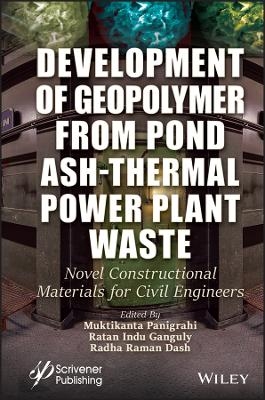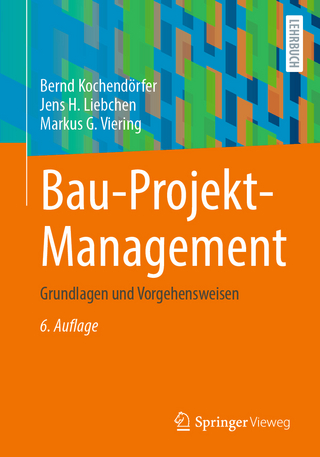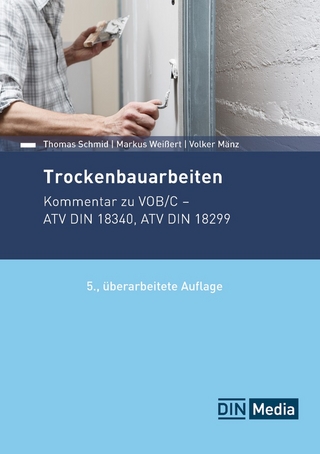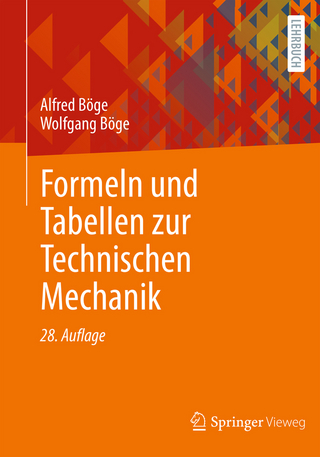
Development of Geopolymer from Pond Ash-Thermal Power Plant Waste
Wiley-Scrivener (Verlag)
978-1-394-16652-7 (ISBN)
- Titel ist leider vergriffen;
keine Neuauflage - Artikel merken
Utilization of waste materials has become a global challenge since they endanger our environment. In this book, the authors demonstrate how to utilize fly ash/pond ash (waste materials from thermal power plants) to produce a novel material called 'Geopolymer' (GP). Red mud, slags, etc., are mixed with fly ash to produce GP with enhanced strength. As shown in a few European countries, GP can replace cement, and some permanent structures constructed with GP are now appearing in a few advanced countries. GP, and geopolymer concrete, is considered suitable for the construction of roads, buildings, etc., and will eventually, fully or partially, replace cement.
The book highlights the mechanism of the formation of GP from pond ash. Properties of structures made with GP concrete are found to be comparable to those made with cement concrete. Systematic investigations are presented to understand the chemistry of GP formation with pond ash materials. Performances of these materials above ambient temperature, as well as with different environmental conditions, are also evaluated.
Audience
The book will be used by civil engineers in the construction and ceramic industries, as well as the industrial waste sector. Researchers in materials science, structural and civil engineering, environmental science, and ceramic engineering, will also benefit. Additionally, the book is suitable for graduate courses in civil engineering.
Muktikanta Panigrahi, PhD, completed his doctorate in materials science at the Indian Institute of Technology, Kharagpur. He is an assistant professor in the Department of Materials Science, Maharaja Sriram Chandra Bhanja Deo University, Odisha, India. He has completed a project on Geopolymer sponsored by the Ministry of Mines, Govt. of India. He has innovations/discoveries in the area of Geopolymer/MMCs/Ceramics/Polymers and is skilled in the field ofbasification of industrial wastes, organic semiconductors, biodegradable polymers, and gas sensors. Ratan Indu Ganguly, PhD, completed his doctorate in materials science at the Indian Institute of Technology, Kharagpur. He has 50 years of experience in academic teaching. He has completed an industry-sponsored project for the development of floor and wall tiles from industrial waste such as fly ash. He is now supporting a research project which relates to the development of geopolymer from pond ash. Radha Raman Dash, PhD, completed his doctorate in materials science at the Indian Institute of Technology, Kharagpur. He has spent decades at the CSIR-National Metallurgical Laboratory (NML), Jamshedpur as a senior scientist. Currently, he is Dean of research and development, Gandhi Institute of Engg. & Technology, University, Gunupur, Orissa. He has ten inventions/discoveries, and his research interests are in the foundry, composite materials, corrosion, ceramic matrix composites, fractal images, and advanced materials.
Preface xi
1 Historical Development of Construction Materials – From Stone Age to Modern Age 1
Ashis Kumar Samal, Muktikanta Panigrahi, Ratan Indu Ganguly and Radha Raman Dash
1.1 Introduction 1
1.2 Chronological Development of Construction 2
1.2.1 Neolithic Age 2
1.2.2 Copper Age and Bronze Age 3
1.2.3 Iron Age and Steel Age 3
1.2.4 Ancient Mesopotamia 4
1.2.5 Ancient Egypt 4
1.2.6 Ancient Greece and Rome 5
1.2.7 Ancient China 8
1.2.8 The Middle Ages 9
1.2.9 The Renaissance 11
1.2.10 The Seventeenth Century 15
1.2.11 The Eighteenth Century 15
1.2.12 The Nineteenth Century 16
1.2.13 The Twentieth Century 17
1.3 Different Types of Ash Used in Construction 18
1.3.1 Wood Ash 19
1.3.2 Rice Husk Ash 19
1.3.3 Cigar Ash 19
1.3.4 Volcanic Ash 19
1.3.5 Quarry Dust 20
1.3.6 Coconut Shell Ash 21
1.3.7 Coal Ash and Fly Ash 21
1.3.8 Fly Ash Generation 24
1.3.9 Nature and Composition of Thermal Power Plant Ashes 24
1.3.10 Pond Ash 29
1.3.11 Various Uses of Pulverized Fuel Ash 31
1.3.12 Importance of Pond Ash Management 32
1.4 Physical Characteristics of Coal Ashes 33
1.5 Coal Ash Utilization 38
1.6 Slag 39
1.6.1 Generation of Slag 40
1.6.2 Slag Properties and Utilization 44
1.7 Geopolymers 45
1.7.1 Constituents of Geopolymers 46
1.7.2 Geopolymer Properties 52
1.8 Durability of Concrete 53
1.9 Accelerated Durability Testing 55
1.10 Conclusion(S) 56
Acknowledgments 56
References 56
2 Fundamentals of Geopolymer Cementitious Materials 71
Muktikanta Panigrahi, Ratan Indu Ganguly and Radha Raman Dash
2.1 Introduction 72
2.2 Parameters of Geopolymer Concrete 78
2.3 Geopolymer Formation Mechanism 78
2.4 Conclusions 81
Acknowledgments 81
References 82
3 Pond Ash (PA)-Based Geopolymer Cementitious Materials 91
Muktikanta Panigrahi, Ratan Indu Ganguly and Radha Raman Dash
3.1 Introduction 92
3.2 Experimental Details 94
3.2.1 Materials 94
3.2.1.1 Pond Ash 94
3.2.1.2 Physical Properties of Pond Ash 96
3.2.1.3 Chemicals 96
3.2.2 Preparation of Geopolymer from Pond Ash 98
3.2.3 Test Methods 100
3.2.4 Results and Discussion 104
3.3 Conclusions 114
Acknowledgments 115
References 116
4 Quantification of Variables on Strength Property of Pond Ash (PA)-Based Geopolymer 123
Muktikanta Panigrahi, Subhasmita Prusty, Ratan Indu Ganguly and Radha Raman Dash
4.1 Introduction 124
4.2 Experimental Details 126
4.2.1 Materials and Method 126
4.2.2 Preparation of Geopolymer from Raw Materials 126
4.2.3 Characterization of Prepared Samples 127
4.3 Results and Discussion 127
4.3.1 Testing of Significance Coefficients 133
4.4 Conclusions 148
Acknowledgments 148
References 149
5 Development of Pond Ash (PA)–High Carbon Ferrochrome (HCFC) Slag-Based Geopolymer Cementitious Materials 151
Muktikanta Panigrahi, Ratan Indu Ganguly and Radha Raman Dash
5.1 Introduction 152
5.2 Experimental Details 156
5.2.1 Source of Materials 156
5.2.2 PA/HCFC Slag-Based Geopolymer (GP) Preparation 157
5.2.3 PA/HCFC-Based Geopolymeric Mortar and Concrete 158
5.2.4 Characterizations of PA/HCFC-Based Geopolymeric Material 158
5.2.5 Results and Discussion 159
5.3 Conclusions 163
Acknowledgments 164
References 164
6 Pond Ash (PA)–Jute Fiber-Based Geopolymer Cementitious Materials 169
Muktikanta Panigrahi, Paresh Biswal, Niharika Patel, Ratan Indu Ganguly and Radha Raman Dash
6.1 Introduction 170
6.2 Experimental Details 175
6.2.1 Chemicals and Materials 175
6.2.1.1 Physical Properties of Jute Fiber 176
6.2.2 PA/Jute Fiber-Based Geopolymer, Mortar and Concrete 178
6.2.3 Results and Discussion 186
6.3 Conclusions 189
Acknowledgments 189
References 189
7 Corrosion of Pond Ash (PA)-Based Geopolymer Products 195
Slipika Panda, Muktikanta Panigrahi, Ratan Indu Ganguly and Radha Raman Dash
7.1 Introduction 196
7.2 Experimental Details 203
7.2.1 Chemicals and Materials 203
7.2.2 Preparation of Pond Ash-Based Geopolymer Products 203
7.2.2.1 Pond Ash-Based Geopolymer Mortar Preparation 203
7.2.2.2 Pond Ash-Based Geopolymer Concrete Preparation 204
7.2.3 Characterizations of Pa-Based Geopolymer GP Mortar/Concrete (Before and After) Corrosion 206
7.2.4 Results and Discussion 207
7.3 Conclusions 220
Acknowledgments 220
References 221
8 Applications, Challenges and Opportunities of Geopolymer Materials 227
Ashis Kumar Samal, Muktikanta Panigrahi, Ratan Indu Ganguly and Radha Raman Dash
8.1 Introduction 228
8.2 Challenges 234
8.3 Opportunity 234
8.4 Conclusions 235
Acknowledgments 235
References 235
Index 241
| Erscheinungsdatum | 11.05.2023 |
|---|---|
| Sprache | englisch |
| Gewicht | 649 g |
| Themenwelt | Technik ► Bauwesen |
| Technik ► Maschinenbau | |
| ISBN-10 | 1-394-16652-4 / 1394166524 |
| ISBN-13 | 978-1-394-16652-7 / 9781394166527 |
| Zustand | Neuware |
| Informationen gemäß Produktsicherheitsverordnung (GPSR) | |
| Haben Sie eine Frage zum Produkt? |
aus dem Bereich


